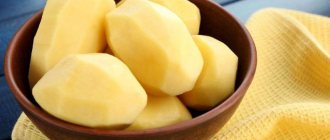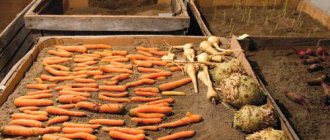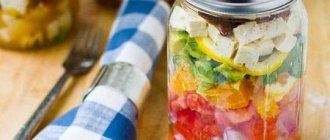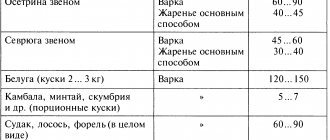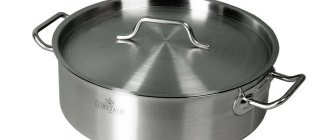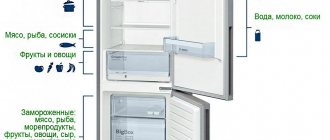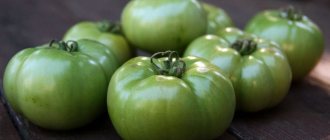Storing vegetables in the cellar Storing vegetables in the basement is no less important than growing and harvesting them. It is important to preserve the most beneficial substances and vitamins.
It is necessary to ensure that the storage conditions correspond exactly to the vegetables and fruits that will be there. Typically, optimal conditions for a basement are: high humidity - up to 95% and low temperature from 0 to +2 degrees. You can learn how to properly store vegetables in the cellar from this article.
Preparing the cellar for harvest storage
Even before the harvest begins, the cellar should be prepared for storing the crop and, first of all, it should be well ventilated.
After this, it is necessary to remove all unnecessary things from the cellar and carry out disinfection, disinfect the walls of the room from possible mold or mildew, and various insects that may appear there. If the walls of the cellar are lined with bricks, then they should definitely be whitewashed. 5% copper sulfate are used as whitewash . Everything in the cellar - shelves, racks, partitions - also needs to be treated with a 10% solution of copper sulfate. When this work is completed, the cellar cannot be closed; it must be left open and allowed to ventilate.
To scare away rodents and various insects that may settle there, it is good to use a proven method. Take two sulfur bombs and set them on fire in the storage room; the sulfur dioxide, which will emit a flame, destroys the “living creatures”. Sulfur blocks are sold at hardware stores, in the “gardening” section. Before lighting the checker, place it on a metal container and then set it on fire in the cellar, after which it should be closed and kept like that for 2 days. Immediately after this, the storage must be thoroughly ventilated.
There are cellars that freeze in winter; if this happens, then the room needs to be insulated. Part of the walls that are at the level of soil freezing is well insulated with sheets of expanded polystyrene.
To better secure them, you can use polyurethane foam or a special glue for this material. In winter, even in severe frosts, insulated walls will help prevent the room from freezing, and vegetables will be preserved better.
Potato storage
After harvesting, it is recommended to keep the potatoes for a week or two before storing them in the cellar. The tubers are covered with dry wormwood. Beets are placed on top, they “take away” excess moisture. It is advisable to have a thermometer in the cellar that allows you to control the “weather”. Be sure to have a thermometer in the cellar. Potatoes are stored well at a temperature of +4-+5 °C.
Advice from gardeners
Anatoly Pleshakov:
— When storing potatoes, I line the floor and walls of the vegetable storage bin with tansy. I sort out the potatoes, let them sit in a darkened room for at least two weeks, and then pour them into the bin. 100% protection against rodents!
Gennady Halliulin:
— It is better to harvest potatoes in dry, warm weather: this way the tubers can be ventilated and dry right on the field. I put the dug up dried tubers in bags in the garage for several weeks. And only then do I put it in the cellar.
Peter Markov:
— I treat the potatoes that are used for food purposes with phytosporin. I treat seed potatoes with the drug “Maxim”. I dry it and store it for storage.
Expert advice
Valentina Ivanovna Kulikova, candidate of agricultural sciences Sciences:
— Potatoes for food purposes should be stored at a temperature of 2-3 °C. If the temperature is more than 6 °C, then the resting period ends and the eyes awaken. You need a thermometer in the storage room, and in severe frosts you should check what the temperature is if you are not sure about your cellar. If the temperature is below two degrees or drops, you need to urgently take action: lower the heater, take dry hay, spread it on top of the potatoes, put beets on top of the potatoes, they take up moisture.
What kind of cellars can there be?
The cellar is a basement room and can be of two types:
- buried;
- semi-recessed.
In order for vegetables to last until spring and retain all their beneficial properties, an optimal temperature for their storage is necessary. The temperature inside the room, as well as its level of humidity . The materials used to construct the cellar are of great importance. The room can also be heated or unheated, but in order to preserve vegetables and preserves, care must be taken to ensure that the temperature is minimal, but positive and without freezing.
Ventilation and insulation of the basement is of great importance; this will contribute to normal temperature conditions and air humidity levels inside the structure. Ventilation can be artificial or natural, so for this purpose, vents are made in the basement, they are opened and the room is ventilated. This helps prevent moisture from forming and then causing mold or mildew to form on the walls. Ventilation can be done artificially using a split system and other modern methods.
Many people confuse a cellar with a basement, although in fact these are different rooms. The basement is usually located under the house and is below ground level . Such a room can be used for various purposes, not just for storing food. Often basements are equipped for workshops, offices, and storage facilities.
The cellar is different in that it can be built in any room, it can be underground or above ground, and such a room is used only for storing vegetables. It creates all the conditions to preserve the harvest as best as possible. Temperature conditions and ventilation contribute to optimal temperature conditions and normal humidity. A cellar is often built not only in private homes or cottages; it can be made in any convenient room. It is usually small in size, but you can store a lot of food in it for the winter.
The area of such a room can vary, it all depends on the needs and wishes; the shape of cellars is often square or rectangular. Almost always there is a hole in the ground for storing vegetables in the room, and shelves and racks are also built for storing canned food and other preparations for the winter.
Floor installation
The construction of a floor in a garage cellar consists of the following steps:
- pouring a layer of crushed stone about 10 cm thick;
- laying a layer of sand 50 mm thick;
- tamping;
- uniform pouring of hot bitumen over the entire floor plane;
- covering the hardened floor with a concrete mixture at least 18 cm thick.
To install the highest quality floor in the garage basement, you should use a reinforced screed made of metal rods, photo.
The concrete floor is covered with bricks or tiles.
Cellar temperature for storing vegetables
For proper storage of vegetables and fruits, old proven methods, as well as new inventions, are used. It is believed that the temperature should not be lower than 0°C, and it is also desirable that the cellar have high humidity at the level of 70-95% .
It is also important to have good ventilation, air circulation and that light does not penetrate into the vegetable storage. Recent Entries
Chainsaw or electric saw - what to choose for the garden? 4 mistakes when growing tomatoes in pots that almost all housewives make Secrets of growing seedlings from the Japanese, who are very sensitive to the soil
It is necessary to try to constantly monitor the temperature and humidity in the cellar. If something is wrong, ventilate the room immediately. There are special devices that can show all important indicators on a sensor; they can make the task easier if installed in the cellar.
It is important to arrange the room so that condensation does not collect on its walls; if the cellar is intensively ventilated, then there will be no problems. The most optimal temperature is considered to be from +8.5 to +2.5°C .
The valve in the cellar needs to be opened and closed periodically; this will be enough to ensure that there is normal temperature and humidity.
Technology for building a basement in a garage
Arranging a basement in a garage should begin with the correct distribution of zones. Let's list what exactly should be in the cellar:
- Entrance to the cellar. It should not be cluttered. Remember that you will have to carry heavy bags and boxes of vegetables through it.
- Door. It should provide reliable protection for the basement from winter cold and summer heat.
- The ceiling in the basement must be strong and reliable; for this it should be insulated and waterproofed.
- The hood should ensure air movement in the basement and prevent it from stagnating in the room.
- Lighting. The cellar must have lighting; its source is often placed near the stairs.
- Workshop. If you plan to make something in the basement, you can arrange a special place for it. The workshop is located so that it does not clutter the space.
The owner of an equipped basement in the garage receives the following benefits:
- creating an optimal climate for long-term storage of food;
- saving home space.
How to store vegetables in the cellar?
The safety of vegetables largely depends not only on storage conditions, but also on how to prepare the vegetables themselves for wintering and under what conditions they will be grown.
For better preservation, the weather conditions in which the crop was grown, the varieties of vegetables and timely harvesting from the beds are also important. Any vegetables must be carefully selected so that they are free from defects and damage . It is best to harvest in dry weather if you plan to store it for the winter. Usually, only 5 types of vegetables, the most popular and widespread, are selected for long-term storage:
- potato;
- carrot;
- beet;
- cabbage;
- onion and garlic.
In addition to these types, horseradish and cucumbers, tomatoes and herbs, pumpkin and eggplants and other root vegetables are also stored. Fruits that are too ripe or unripe are not suitable for long-term storage, since some will rot quickly and others will wither. Now it’s worth taking a closer look at each of the vegetables and knowing how to select them correctly and preserve them for a long time so that they have a fresh appearance and beneficial properties.
Potatoes and carrots
All harvested potatoes should be dried for several hours, preferably in an unlit place, and clods of earth should be removed. It is best to keep the harvest in a dark room for 10-12 days so that it can rest there. The optimal temperature for storing potatoes should be 2-4°C, with a humidity of 90%. Before putting the potatoes into the cellar, they need to be sorted into large and small.
It is advisable to store potatoes separately in boxes with holes or in baskets 80-100 cm in height. Containers cannot be placed on open ground; it is better to place them on a wooden platform made of bars, 10-15 cm high . Containers should not touch the walls of the cellar, and the boxes or boxes themselves should not be too close to interfere with air movement. Potatoes are often sprinkled with sawdust or rowan leaves, this helps to preserve them better.
Carrots should be dried in the sun, the tops should be cut off so that they cannot germinate. You can store it in several ways:
- in dry sand;
- in plastic open bags;
- wrapped in newspaper;
- in pine sawdust;
- in clay, carrots are dipped in a clay solution, allowed to harden and lowered;
- in chalk solution;
Carrots ready for storage are placed in boxes or baskets. It is very important that the temperature does not drop below +1°C and the humidity is 90%, then the vegetable will overwinter well. If there is not enough humidity, then you can put liquid with water in the cellar or cover the boxes with wet fabric bags.
Beetroot and cabbage
Beets also need to be kept in the open air and the tops trimmed before being placed in the cellar. She will be able to lie there perfectly until spring, the main thing is that the room is cool. The beets can be placed in boxes and placed one on top of the other, on a wooden stand, 10-15 cm high , not close to the wall.
It is very difficult to preserve cabbage in an ordinary cellar; the ideal option for preservation is a village cellar. The temperature for its storage should be within -1 to +1°C with a humidity of 90-98%. Before the onset of frost, the harvest is harvested and the heads of cabbage are hung by the root in a draft so that the cabbage can dry for several days. It should also be stored in a suspended state in the cellar. A good option for storing cabbage is to place it on a wire shelf .
Harvesting and storing root vegetables
To prevent carrots from being affected by rot during the growing season, the seeds must be kept in a thermos at 50 °C for 10 minutes before sowing. The tops of root crops are cut off immediately after being pulled out, as they draw out moisture. I make sure to wash beets, celery, radishes and carrots. When harvesting, I cut the tops flush with the shoulders, that is, flush with the growing point. Carrots are harvested in the late afternoon; they are sweeter.
Anastasia Timofeevna Lebedeva, candidate of agricultural sciences Sciences:
— During storage, carrot roots sprout and their quality decreases. If the heads of root crops are completely cut off, then nutrients will not move to the apical bud.
I harvest radishes, daikon, and celery later than beets, but earlier than carrots. The harvest is pleasant to hold in your hands: the large round roots of celery are surprisingly good. I cut off the green tail of the leaves and dry them - they have a characteristic, pleasant smell, and some authors advise using dried celery leaves in winter instead of parsley, the leaves of which have a weak smell after drying. Root vegetables are stored well, since after washing they reveal defects; I discard damaged ones; they have no place in the cellar. I dry everything. And then the men lower the vegetables into the cellar. A week or two later, having chosen a free day, I go down to the cellar and begin sorting. At the same time, I select broken or damaged root vegetables that I looked through before storing.
Previously, we covered carrots with sand, but for the last twenty years we have been storing all our vegetables in bags, and they remain in the cellar without any problems until the next harvest. In plastic bags (I take two bags, putting one inside the other) I put celery root, parsley, beets, or even two or three, carrots - about ten. It’s very convenient: we came to buy vegetables, my husband went down to the cellar, he doesn’t need to collect vegetables from the bins, everything is at hand, he took one or two bags, and that’s enough for a week or two. When celery is brought to me from the cellar, I wash the root vegetables again (after harvesting, I wash them, like carrots and beets), peel, cut into pieces and add white roots to any dishes.

